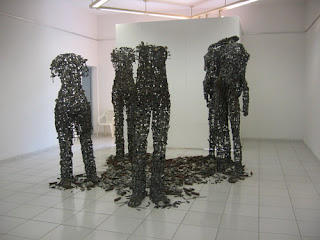
By Bisi Silva
DAKAR, Senegal—On May 9, the eighth edition of the Dakar Biennale was officially opened by Senegalese president Abdoulaye Wade, in a ceremony involving the usual pomp, pageantry, political mutterings, and half-hearted promises to support and develop visual art education and infrastructure. For 16 years Dak’Art has provided the only consistent large-scale platform for the presentation of contemporary artistic production south of the Sahara. While each edition bears witness to the event’s growing importance as a meeting point for art professionals from around the world, this year’s biennale falls short of leveraging its position as Africa’s most important visual art platform.
Dak’Art 08, which runs May 9 to June 9, presents some 50 works by 36 artists from 16 countries — including three from the diaspora — across two official venues, under the broad theme of “Africa: Mirror?” The framework calls for a critical reflection on the failures and successes of post-colonial Africa as many of its nations prepare to celebrate 50 years of independence in 2010, and the biennale, to its credit, includes a substantial number of projects relating to African and diaspora themes — from African history, colonialization, conflict, displacement, and migration to rural/urban and modern/traditional tensions. However, in spite of a few interesting projects, this year’s biennale represents a major step backward for the event.
Since its inception in 1992, Dak’Art ran for many years without a curatorial team, a situation quite unusual for a major biennale. Artists were invited to apply, and an international committee whose members were sometimes unfamiliar with the applicants determined the final selection. In 2006, the limitations of this selection process were finally addressed, and the biennale was organized by a curatorial team of six (disclosure: I was one), under the leadership of artistic director Yacouba Konate. The result was an ambitious affair spread over four venues, including the extensive grounds and ancillary spaces of the Theodore Monod Museum, and featuring over 85 artists and 120 artworks from 27 African countries and 4 in the diaspora.
This year, unfortunately, all of those positive developments have been reversed. (MORE....)


Nessun commento:
Posta un commento
YOURS COMMENTS ARE ALWAYS APPRECIATES